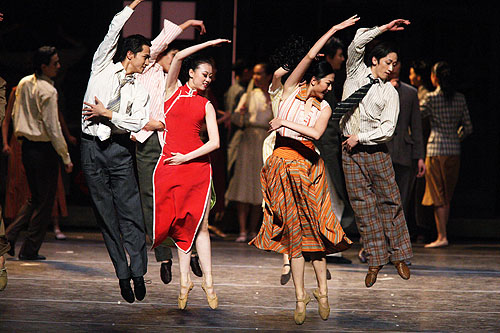|
 |
|
Du Xiaoqing (COURTESY OF DU XIAOQING) |
Du Xiaoqing, Executive Editor in Chief of Dance magazine, the leading professional dance periodical in China sponsored by the Dancers Association of China, sat down with Beijing Review reporter Zan Jifang recently to share her understanding of the development of ballet in China
Beijing Review: Could you introduce the history of ballet in China?
Du Xiaoqing: The development of ballet in China started between the 1920-30. It was brought to China by Russians, especially to the big cities like Shanghai, Harbin and Tianjin. The Russians set up private ballet schools, the earliest of their kind in China. Later, European and American ballets also presented small-scale performances in these cities. Although, at that time, only small groups of people had access to this Western art form, these foreign ballet schools and performances played a critical role in introducing the art to the Chinese people.
 |
|
In the Mood for Love, Shanghai Ballet (CFP) | The real beginning of ballet in China was in 1954, when the Beijing Dance School (today's Beijing Dance Academy) was founded, and ballet became one of its subjects. Since then, ballet has developed systematically in China.
During the 1950s and 1960s, ballet entered a period of rapid development. In 1959 the Experimental Ballet of the Beijing Dance School was founded, the first professional ballet in the country and the progenitor of today's National Ballet of China. The graduates of the school's ballet major became the first members of the troupe. From then on, the first generation of Chinese ballet teachers, choreographers and dancers gradually emerged, and ballet teaching, creation and performance systems were basically formed in China.
At that time, teaching at the school and the development of the troupe received the help of Russian ballet artists led by ballet master Pyotr Gusev. He put forward the idea of combining Western ballet with cultural elements from China, and that was agreed on by Chinese artists. Based on these ideas, the troupe not only performed classic Western ballets such as Swan Lake, but also started to create new works in Chinese style such as Fish Beauty, which was adapted from a Chinese legend. The trial performance of Fish Beauty was a big hit at the time, and it also marked the beginning of Chinese ballet artists' exploration of incorporating Chinese elements into ballet.
How did ballet boom in China?
During the "cultural revolution" (1966-76), a disastrous period for China's cultural and artistic creation, ballet had special opportunities to develop. Chinese ballet artists created some new works with themes related to Chinese revolution, such as The Red Detachment of Women and The White-Haired Girl. These two ballets became a milestone in the creation of dramatic ballet in China. They stunned the world with their unique Chinese characteristics.
The other important role of these works was that they greatly popularized this Western art form in China. At that time, because of great popularity of the two works, many non-ballet singing and dancing troupes also rehearsed the two works, and even ordinary young dance lovers imitated the moves.
Another peak for Chinese ballet came in the 1980s, when China started to carry out its policy of reform and opening up. China developed far greater communication with foreign ballet artists and troupes, which helped broaden the Chinese artists' horizons. Before that, the Russian ballet school was the only source that Chinese ballet artists had learned from, and that definitely helped to lay a solid classical foundation for China's ballet development. After the opening up, European and American ballet works and theories were gradually brought to China, and that opened up another window on the art of international ballet to the Chinese.
What impressed Chinese ballet circles most was the German Stuttgart Ballet's Eugene Onegin by John Cranko, the troupe's artistic director and a master of choreography. This ballet drama combined dance and plot perfectly. All the characters were brought forward and the plot developed exceptionally well through dance. It was very different from the traditional and classical drama ballet that Chinese ballet artists had learned and were familiar with. It brought a new conception of dramatic ballet creation to China and greatly influenced its later development in China. The influence even extends to today. Eugene Onegin is now considered a standard, classic dramatic ballet by Chinese ballet circles.
Entering the 21st century, China's ballet ushered in a flourishing new phase, featuring greater diversity. All kinds of genres appeared, such as dramatic, modern and contemporary, as well as ballet assimilating Chinese cultural elements. Chinese ballet dancers not only successfully present world classical works, but also those new creations of internationally famous contemporary ballet choreographers. A greater amount of communication and cooperation with international ballets has taken place. Foreign choreographers were invited to China quite often, and Chinese choreographers also helped foreign ballets to create ballet works. For example, in 2006, the Royal Danish Ballet invited Wang Yuanyuan, Director of the Beijing Contemporary Dance Theater, to choreograph The Color of Love, the first time the company had commissioned work from a Chinese choreographer.
|
